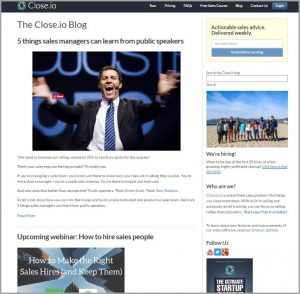The better you understand your prospect, the more efficient and effective your B2B prospecting will be, and no one silo or point of view within the company is going to give you the “who,” “what,” and “why” of prospects and the buying process.
The answer is to triangulate intelligence or we are no more effective than the blind men of poetry, trying to determine what an elephant really “looks like” with each touching the strange beast once from a different angle.
Let’s prove the point.
The Elephant in the Room
The prospect is the elephant in the room, and while no one perspective yields a true and complete portrait, there is no monopoly on insight, grasshopper.
Here’s the three-sided equation, or the three points of intelligence you need to grok:
- Data analysis adds an important dimension in recognizing what prospects are doing now. It’s immediate and improves targeting and enables greater efficiency. However, it doesn’t provide depth to the “who” and the “why” of the behavior which leads us to include Sales’ internal intelligence.
- Internal intelligence. Sales talks to the elephants all day long, every day. We can tap into their real-world knowledge, both of the individuals and the specific accounts. Marketing needs more depth on the real people who we are calling prospects.
- Persona research. Creation of a prospect person, or personas, based upon new qualitative research, yields the human insights into the individuals who comprise the buying center, their own values, perspectives, and agendas. It takes the learning from behavioral data analysis and inside intelligence and matches it with motivation.
The Elephant Revealed
Let’s see how this plays out in reality with a very prestigious firm which breathes the very rarefied atmosphere of derivative accounting, helping their clients (including Google) to mitigate foreign currency risk through consulting and outsourcing. Long seen as unassailable experts, they have made their reputation by being smarter, better prepared, and more proactive than their much larger competitors.
They recently introduced a highly-specialized software package, but results were not pacing with expectations. To really understand the prospect, and to improve their B2B prospecting, they had to triangulate.
- Data Analysis. This is reality and not a mega B2C company with oceans of data. The current data was on Salesforce but the history was on Excel (and some in personal recollection). When the sources were compiled and matched to the products and services purchased, it became obvious that the strength of the individual relationships they had forged―individuals were clients of one service, then became prospects for another, sometimes at a different company, then clients again.
- Internal Intelligence. The internal view was that the software is unique and robust. The tie-breaker was that everything is based on their insight and expertise, which is without peer. Sales felt they could now compete as a software company.
- Persona Research. The research validated the data analysis and the internal intelligence, and added a critical component―motivation―which changed the entire picture. Prospects were looking for an expert that also offered software. They needed to engage with people who could help them to better understand how to make the right decisions and then to install the software that could provide better decision support.
“Seeing” the B2B Prospecting Opportunity
Much comes from this triangulation, not the least that as pioneering experts in this very specialized accounting field, the client understandably believed they already knew how to position and sell the software. Markets evolve, even in accounting and more than one might think. We all need a regular dose of outside B2B prospecting perspective.
Here are some of the takeaways:
- Long-term relationships are a competitively differentiating asset and constitute the investment with the highest return. A client is a prospect is a client (And really, B2B prospecting is a personal sell.),
- Education is a critical component. Rebrand the firm’s training classes as a professional institute.
- Stop leading with software. The untapped potential, in this case, comes from being who your client needs you to be and when by walking down the consideration journey arm in arm. Software comes later in the continuum of the relationship. Software first is selling the elephant’s tail. Help them to “see” the rest of the elephant first, and then they can appreciate what’s missing.
Full Circle
Again, any one point of view can be true but still not account for the totality of the situation. Putting data analysis together with internal intelligence and persona research, we start to get a glimpse of that strange and wonderful beast, our prospect.
Or as one of this firm’s clients said, “Are they expensive―you bet. But they are worth every penny. First they installed best practices. Then the software to make it efficient.”
Business & Finance Articles on Business 2 Community(32)
Report Post






